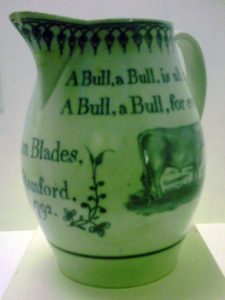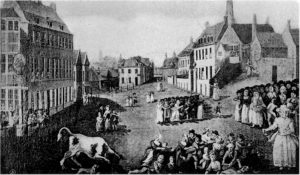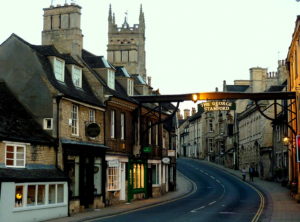I love finding local events to include in books. They can be fun inciting events, or random bits of action, or just a bit of historical authenticity. It’s the little things like this that add verisimilitude and depth to a book (at least in my opinion). One of my go-to sources for this kind of thing is The English Year by Steve Roud. It’s an absolutely fabulous book that goes through the whole year listing events and celebrations all over England. I’ve used something out of it for every book.
So, if we were dropped into Georgian England this week, what might happen? Well, if it happened in the city of Samford, we might get trampled by bulls. On Nov 13th (or the 14th if the 13th fell on a Sunday as it did this year), the Stamford Bull-Running took place up until the 1839 when it fell afoul of reformers.
According to local tradition, the custom was started in the 12th century by William de Warenne, 5th Earl of Surrey, after he saw two bulls fighting in the meadow. When the butchers tried to part them, the bulls ran into the town. The earl so enjoyed the resulting ruckus (and giving chase) that he decreed it would be an annual event.

A jug commemorates Ann Blades – a Stamford bull runner in 1792 (photo by Roger from Derby, UK Wikimedia Commons)
The city would block off side streets and board up windows. At 10:35AM the church bells would ring, alerting people to clear the street, and then the bull would be released and the crowd of “bullards” and their dogs would chase it through the main thoroughfare. When they reached the bridge, the bull would be tossed over into the water, and then pursued into the field, slaughtered, roasted and eaten (later the meat was sold off cheaply, rather than cooked and consumed on the meadow).
By the late 18th century, bloodsports (and anything that involved riotous celebration by the poor and working class) were falling out of favor. The local paper in 1785 commented:
“Monday last being our annual bull-running, the same was observed here with the usual celebrity—several men heated with liquor got tossed by the bull, and were most terribly hurt, while some others more sober had little better usage. What a pity it is so barbarous a custom is permitted to be continued, that has no one good purpose to recommend it, but is kept as an orgy of drunkenness and idleness to the manifest injury of many poor families, even tho’ the men escape bodily hurt.”
The bull-run became a major cause for reformers, and was first banned in 1788, but the powers that be were unable to suppress the custom and eventually gave up trying. The cause was again taken up in 1824 by the newly formed Society of the Prevention of Cruelty to Animals, and ending it (by turning the tide of local opinion) was their first major success. [ok, so this was an entirely unexpected discovery when I chose this topic, it’s a twofer for anyone wanting to write an authentic reformer hero or heroine!).
So, happy St. Brice’s day! Be glad you weren’t trampled by a bull.



I thought this only happened in Spain. Thanks, Isobel!
Well, this is one bull, not a whole herd of them. There was another one in England too, but I’m at work and don’t have access to the book to look it up.
It’s beautiful! Nice blog post. I like this very mutch.